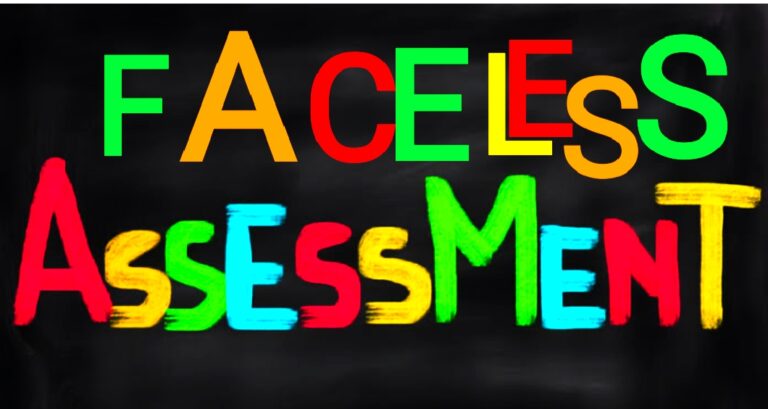Faceless Assessment Scheme in Income Tax
Faceless assessment, often referred to as ‘Jurisdiction-less Assessment’ is a revolutionary approach to income tax assessment procedures under Section 144B of the Income Tax Act, 1961. This article aims to provide a comprehensive guide to understanding faceless assessment Scheme in Income Tax and the step-by-step process involved in this modernized approach to income tax assessment.
What is a Faceless Assessment?
Faceless assessments are named so because the assessees no longer interact with a specific assessing officer in person. Instead, the entire process is conducted electronically, utilizing advanced technologies such as artificial intelligence and machine learning. The objective is to reduce discretionary powers and streamline the assessment process.
What is a Jurisdiction-less Assessment?
These assessments are ‘jurisdiction-less’ because they are not conducted by a single assessing officer but by a team of expert Income Tax Officers at multiple levels. The process involves National Faceless Assessment Centre (NaFAC), Assessment Unit, Verification Unit, Technical Unit, and Review Unit.
Restructuring and Re-organization of the Income Tax Department
 Section 144B(3) of the Income Tax Act empowers the Central Board of Direct Taxes (CBDT) to establish the following centers and units, each with specific functions and jurisdictions:
Section 144B(3) of the Income Tax Act empowers the Central Board of Direct Taxes (CBDT) to establish the following centers and units, each with specific functions and jurisdictions:
(i) National Faceless Assessment Centre (NaFAC): This centralizes the faceless assessment proceedings.
(ii) Assessment Units (AU): Responsible for conducting assessments, identifying key issues, and seeking information from the assessee.
(iii) Verification Units (VU): Conducts verification, including examination of books, witnesses, and recording statements.
(iv) Technical Units (TU): Provides technical assistance on various matters under the Income Tax Act or international agreements.
(v) Review Units (RU): Reviews income determination proposals and checks for accuracy and completeness.
Procedure of Conducting Faceless Assessments
 All regular assessments under Sections 143(3), income escaping assessments under Section 147, and best judgment assessments under Section 144 are conducted in a faceless manner. The process can be broken down as follows:
All regular assessments under Sections 143(3), income escaping assessments under Section 147, and best judgment assessments under Section 144 are conducted in a faceless manner. The process can be broken down as follows:
(i) Assignment of Case: NaFAC assigns the case to a specific Assessment Unit through an automated allocation system.
(ii) Notice and Response: Notices are served through NaFAC, and the assessee can respond electronically.
(iii) Requisition for Information: The Assessment Unit may request further information or documents from the assessee through NaFAC.
(iv) Verification Requests: If needed, the Assessment Unit can request verification through the Verification Unit via NaFAC.
(v) Technical Assistance: The Assessment Unit can seek technical assistance from the Technical Unit through NaFAC.
(vi) Personal Hearing: If a variation is proposed, the assessee can request a personal hearing, which is conducted through video conferencing.
(vii) Preparation of Draft Order: Based on responses, the Assessment Unit prepares an income or loss determination proposal.
(viii) Review and Modifications: The proposal may be reviewed by the Review Unit, and modifications are made if necessary.
(ix) Final Assessment Order: The final assessment order is passed by the Assessment Unit in non-eligible cases or in compliance with directions from the Dispute Resolution Panel for eligible assessee cases.
(x) Transfer of Records: All electronic records are transferred to the jurisdictional Assessing Officer for further action.
Step-by-Step Guide to Faceless Assessment Proceedings
 Step 1: Visit the e-filing portal: Assessees must log in to the Income Tax e-filing portal (https://www.incometax.gov.in/iec/foportal).
Step 1: Visit the e-filing portal: Assessees must log in to the Income Tax e-filing portal (https://www.incometax.gov.in/iec/foportal).
Step 2: Log in to Your Account: Use your PAN as the user ID and password to log in.
Step 3: Access e-Proceedings: Navigate to ‘Pending Actions’ and click on ‘e-Proceedings’ to view assessment notices.
Step 4: View Assessment Notices: To view assessment proceeding details, select ‘Assessment Proceedings under Section 143(3)/147 > View Notices.’
Step 5: Select the Notice: Choose the relevant notice under Section 143(2) or 142(1).
Step 6: Download the Assessment Notice: Download the notice for a detailed view of its contents.
Step 7: File ‘e-Response’: Respond to the notice by clicking on ‘Submit Response.’
Step 8: Tips for Filing Responses: Ensure your responses are filed in the appropriate manner, whether partial or full.
Step 9: Requisition for Information (if needed): The Assessment Unit may request further information, documents, or evidence.
Step 10: View and Retrieve Scrutiny Questionnaire: Access the scrutiny questionnaire under Section 142(1) and respond accordingly.
Step 11: View ‘e-Responses’: Review and access the responses you have filed.
Step 12: Download ‘e-Responses/Submissions’: Download all submitted responses and attachments.
Step 13: Preparation of Income or Loss Determination Proposal: The Assessment Unit prepares a proposal based on all available information.
Step 14: Examination by NaFAC and Show Cause Notice: NaFAC reviews the proposal and either finalizes the assessment or issues a show cause notice to the assessee.
Step 15: Filing of ‘e-Response’ to the Show-Cause Notice: Assessees respond to the show-cause notice with relevant documents.
Step 16: Passing of Final Assessment Order by NaFAC: NaFAC reviews the responses and passes the final assessment order, which is available for download.
Step 17: Transfer of Assessment Records: All records are transferred to the jurisdictional Assessing Officer for penalty and recovery actions.
Conclusion
Faceless assessments have brought transparency, efficiency, and reduced discretion in the income tax assessment process. By following this step-by-step guide, taxpayers can navigate the faceless assessment procedures with ease and ensure compliance with tax regulations.
For a More Detailed Study on Faceless Appeals CLICK HERE
To Know About Faceless Appeal Scheme Under Income Tax CLICK HERE
You May Also Like-
